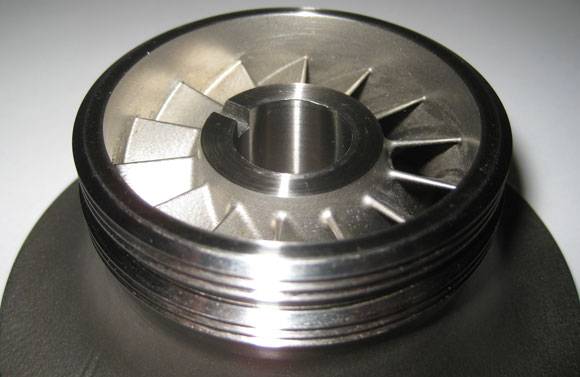
Following surface finishing using PostProcess’s Hybrid DECI Duo solution, the impeller consistently passed aerodynamic tests (Courtesy PostProcess Technologies)
[ihc-hide-content ihc_mb_type=”show” ihc_mb_who=”reg” ihc_mb_template=”3″ ]
[vc_row][vc_column][vc_column_text]Credits: www.metal-am.com
In a new case study, PostProcess Technologies, Buffalo, New York, USA, reports that its automated surface finishing technology has delivered excellent surface finish standards and replicable results to exacting requirements for complex additively manufactured titanium and nickel alloy shrouded impellers. The impellers, produced by Ingersoll Rand, Dublin, Ireland, required tight tolerances for aerodynamic testing and a high level of surface finish for aerodynamic performance.
Aerodynamic performance largely depends on the level and consistency of surface finish; Computational Fluid Dynamic (CFD) calculations for boundary layer formation and other flow requirements use surface finish values, and surface roughness and inconsistencies invisible to the eye will compromise the results. Outstanding surface finishes are therefore essential to meet performance thresholds of components such as impellers.
Ingersoll is currently in the process of adopting metal Additive Manufacturing to produce its shrouded impellers due to the quicker lead-times and higher geometric complexity the technology offers. However, due to the nature of AM, the newly developed impellers are produced at an Ra (roughness average) value that does not meet the engineering team’s specifications. This problem is further compounded by the existence of long internal channels in the part measuring less than 12.7 mm (0.5 in) wide and 127-177.8 mm (5-7 in) long.
The Ingersoll engineering team stated that it has employed multiple surface enhancement methods including manual sanding, grinding tools, chemical etching and combinations of these, achieving results which lacked the quality and consistency required. Using PostProcess’s automated Hybrid DECI Duo solution, Ingersoll obtained consistent and repeatable Ra results for the impellers, with these results being proven through benchmark testing. The technology reportedly delivered parts that consistently passed aerodynamic tests, with an average of 70-80% reduction in Ra for parts run for twenty minutes or less.
Ioannis Hatziprokopiou, Mechanical Engineer, New Product Development, Ingersoll Rand Compression Technologies & Services, stated, “We have chosen the DECI Duo because of its repeatability, minimal setup, processing times and cost of ownership. Photochemical machining, extrude honing and micro-polishing or micro-machining all yield very good results when applied correctly, however extensive tooling and equipment costs, set-up times and required DOEs prior to applying the surface finishing method to obtain a repeatable process have made the DECI Duo a better option.”
In addition, some of aforementioned finishing techniques unevenly remove material inside the flow path of the impeller, whereas the DECI Duo uniformly treats the entire surface of the flow path. The final geometry of the flow path must remain as unaltered as possible after post-processing of any kind,” he concluded.[/vc_column_text][/vc_column][/vc_row]
[/ihc-hide-content]
Building on their established successes in India and the USA, EOS and Phillips Machine Tools…
CPAC, a subsidiary of SCG, has entered into a significant partnership with SAMSUNG E&A to…
A research team from Graz University of Technology (TU Graz) in Austria has introduced two…
Aircraft maintenance plays a critical role in today's aviation industry, especially given the current challenges…
Calum Stewart Calum Stewart, a leading figure at SPEE3D, has been at the forefront of…
The Vice President of Rolf Mack at KraussMaffei talks about the future vision of Additive…
This website uses cookies.